The Intel Kaby Lake-X i7 7740X and i5 7640X Review: The New Single-Threaded Champion, OC to 5GHz
by Ian Cutress on July 24, 2017 8:30 AM EST- Posted in
- CPUs
- Intel
- Kaby Lake
- X299
- Basin Falls
- Kaby Lake-X
- i7-7740X
- i5-7640X
Benchmarking Performance: CPU Rendering Tests
Rendering tests are a long-time favorite of reviewers and benchmarkers, as the code used by rendering packages is usually highly optimized to squeeze every little bit of performance out. Sometimes rendering programs end up being heavily memory dependent as well - when you have that many threads flying about with a ton of data, having low latency memory can be key to everything. Here we take a few of the usual rendering packages under Windows 10, as well as a few new interesting benchmarks.
All of our benchmark results can also be found in our benchmark engine, Bench.
Corona 1.3: link
Corona is a standalone package designed to assist software like 3ds Max and Maya with photorealism via ray tracing. It's simple - shoot rays, get pixels. OK, it's more complicated than that, but the benchmark renders a fixed scene six times and offers results in terms of time and rays per second. The official benchmark tables list user submitted results in terms of time, however I feel rays per second is a better metric (in general, scores where higher is better seem to be easier to explain anyway). Corona likes to pile on the threads, so the results end up being very staggered based on thread count.
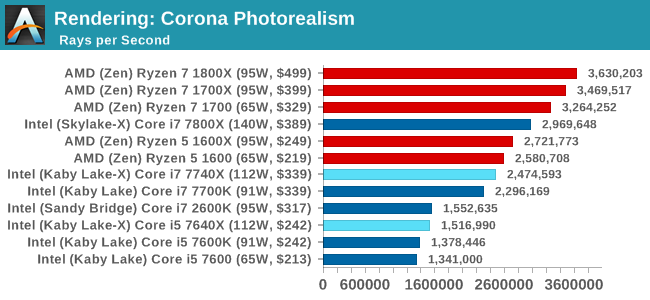
More threads win the day, although the Core i7 does knock at the door of the Ryzen 5 (presumably with $110 in hand as well). It is worth noting that the Core i5-7640X and the older Core i7-2600K are on equal terms.
Blender 2.78: link
For a render that has been around for what seems like ages, Blender is still a highly popular tool. We managed to wrap up a standard workload into the February 5 nightly build of Blender and measure the time it takes to render the first frame of the scene. Being one of the bigger open source tools out there, it means both AMD and Intel work actively to help improve the codebase, for better or for worse on their own/each other's microarchitecture.
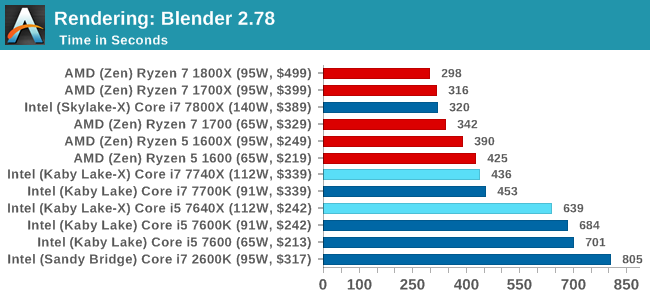
Similar to Corona, more threads means a faster time.
LuxMark v3.1: Link
As a synthetic, LuxMark might come across as somewhat arbitrary as a renderer, given that it's mainly used to test GPUs, but it does offer both an OpenCL and a standard C++ mode. In this instance, aside from seeing the comparison in each coding mode for cores and IPC, we also get to see the difference in performance moving from a C++ based code-stack to an OpenCL one with a CPU as the main host.
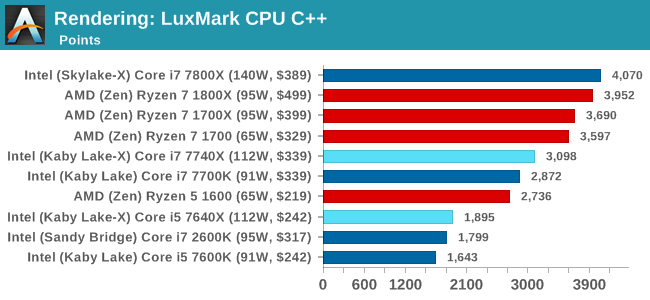
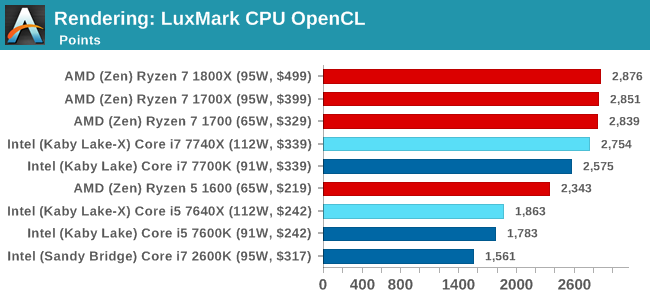
Luxmark is more thread and cache dependent, and so the Core i7 nips at the heels of the AMD parts with double the threads. The Core i5 sits behind the the Ryzen 5 parts though, due to the 1:3 thread difference.
POV-Ray 3.7.1b4: link
Another regular benchmark in most suites, POV-Ray is another ray-tracer but has been around for many years. It just so happens that during the run up to AMD's Ryzen launch, the code base started to get active again with developers making changes to the code and pushing out updates. Our version and benchmarking started just before that was happening, but given time we will see where the POV-Ray code ends up and adjust in due course.
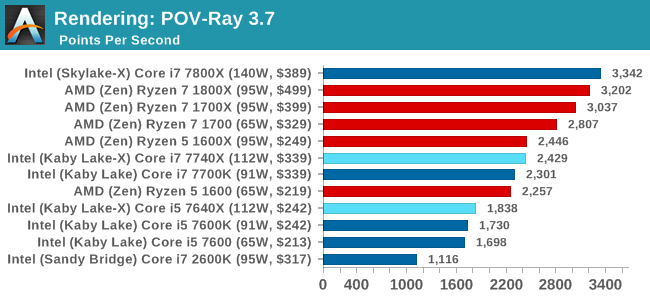
Mirror Mirror on the wall...
Cinebench R15: link
The latest version of CineBench has also become one of those 'used everywhere' benchmarks, particularly as an indicator of single thread performance. High IPC and high frequency gives performance in ST, whereas having good scaling and many cores is where the MT test wins out.
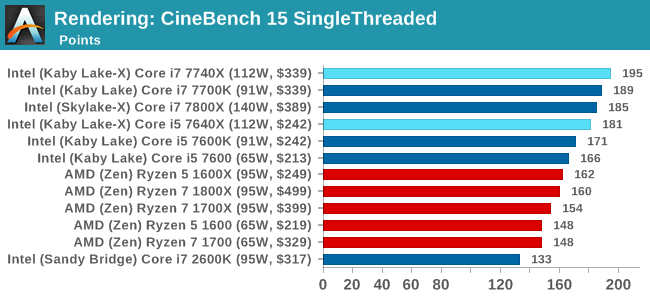
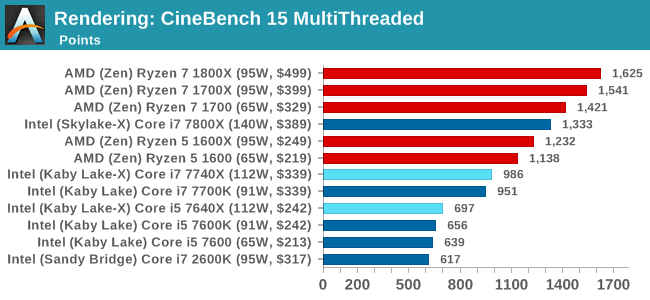
CineBench gives us singlethreaded numbers, and it is clear who rules the roost, almost scoring 200. The Core i7-2600K, due to its lack of instruction support, sits in the corner.










176 Comments
View All Comments
Firebat5 - Tuesday, July 25, 2017 - link
Ian,i'm interested in the details of the agility benchmark? how many photos are in your dataset and at what resolution? am doing similar work and i notice the working time doesn't seem to be linear with the number of photos.
Firebat5 - Tuesday, July 25, 2017 - link
agisoft* autocorrect strikes again.damianrobertjones - Thursday, July 27, 2017 - link
Capitals can be a good thing.Gothmoth - Tuesday, July 25, 2017 - link
reading this article again i must say im realyl ashamed. anandtech was once a great place but now it´s just like car magazines. who pays best gets the best reviews. where is the criticism? everyone and his grandmother things intel has big issues (tim, heat, pci lanes nonsense product) are you bend over so intel can inject more money more easily?damianrobertjones - Thursday, July 27, 2017 - link
Is your shift key broke? Where's are your capitals?zodiacfml - Wednesday, July 26, 2017 - link
Impressive benchmarks. I could not ask for more. This revealed that Intel clearly doesn't have the premium or value position anymore. It is simply not there. They have to be in the 10nm process now to be superior in value and/or performance.Walkeer - Wednesday, July 26, 2017 - link
Hi, what RAM frequency is the AMD platform running on? if its the official maximum of 2666MHz, you can get +10-15% more performance using 3200MHz or faster memorywarner001 - Wednesday, July 26, 2017 - link
Hey, This is a very useful post for the new ones. Thanks a lot. please visit http://forums.cat.com/t5/user/viewprofilepage/user...warner001 - Wednesday, July 26, 2017 - link
nice blogedsib1 - Wednesday, July 26, 2017 - link
Please redo the Ryzen benchmarks using DDR3200 now it is officially supported, and also use the latest updates of the games - eg ROTR v770.1+ where Ryzen gets a 25% increase.You can't compare one platform with the latest updates, and the other without - thats pointless